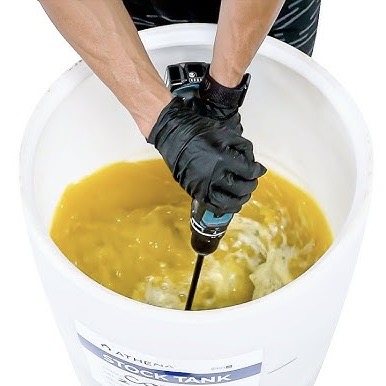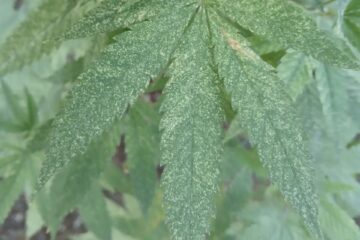What is a Nutrient Stock Solution?
Nutrient stock solutions are made from dissolving dry fertiliser powders in water at a high concentration. These concentrated nutrient stock solutions are then used to mix tanks and feeds for plants. Nutrient stock solutions are also how dry nutrient powders can be used with auto dosing pumps.

Why Make A Nutrient Stock Solution?
Depending on the type of nutrients, they are usually a blend of compounds. These can include potassium sulphate, monopotassium phosphate and magnesium sulphate. These products can often have different particle sizes. Smaller particles usually sink to the bottom, while larger particles will be found toward the top. This can lead to nutrient imbalances when measuring out small amounts of dry fertiliser. Avoid this by making a nutrient stock solution with your dry powders first.
What Water To Use?
Using the “cleanest” water possible is best. Reverse Osmosis is first prize for nutrient stock solutions, as it contains very few minerals. It’s often sterilised and all solid particles are filtered out.
Municipal tap water is second best which in most cases is perfectly fine to use. It does contain small amounts of calcium and other minerals but not to the extent to cause problems.
Rain water would be next in line. However, if it’s been standing for some time, it can have bacteria in it. If you plan to use rain water, perhaps run it through a simple filter, and heat to a boil to aid in killing living organisms.
Avoid using borehole water if you can as it’s not ideal. Borehole water usually has high levels of calcium and other minerals. This calcium can bond with your powders when making a stock solution. When this happens, essentially fewer nutrients are available to your plants.
Ratios According To Brands:
Here are some ratios per litre of water that brands recommend for a nutrient stock solution.
- Athena Pro Line – 226g/L (906g = 4.5L Concentrate, 2.2kg = 10L Concentrate)
- Hydroflow – 200g/L (1kg = 5L Concentrate, 25kg = 125L Concentrate)
- Monopotassium Phosphate – 200g/L (1kg = 5L Concentrate, 25kg = 125L Concentrate)
- Calcium Nitrate 200g/L (1kg = 5L Concentrate, 25kg = 125L Concentrate)
- Potassium Sulphate – 100g/L (1kg = 10L Concentrate, 25kg = 250L Concentrate)
- Magnesium Sulphate – TBC
- Green House Feeding(All Products) – 60g/L (1kg = 16.5L Concentrate)
Athena Pro Bloom(Opens in a new browser tab)
Preparing a Nutrient Stock Solution
Time needed: 30 minutes
Items Needed: Correct sized container with volume marks, dry fertiliser, water, stirring tool.
- Fill container to 70% final volume
Add water to your container reaching 70% of the final volume of stock solution you plan to prepare. If you are making 5L, then fill to around 3.5-4L of water.
- Add dry fertilisers
Add your dry fertilisers to your container of water, stirring and agitating as you go.
- Mix well
Dissolve all dry fertilisers by mixing well. Leave it to stand for up to 30 mins if needed.
- Top up with water
Fill the container to its final volume with water once powders are dissolved.
- Store
Store your nutrient stock solution in a cool dry place with the lid tightly closed.
How to Use a Nutrient Stock Solution
If you made 5 litres of nutrient stock solution from 1kg of fertiliser, then it’s safe to say that 5ml of solution would equal 1g of dry fertiliser. So if the feeding chart indicates for example 8g of dry fertiliser for every 10L of water, you would add 40ml of nutrient stock solution.
When using your stock solution concentrates to mix a feed, make sure to rinse any pipettes you may be using in between different solutions with clean water. If cross contamination occurs, sediment can become visible in your stock solution. These nutrient sediments that have fallen out of solution are not available for uptake. This can easily lead to imbalances in your feeding and deficiencies in your plants.
When mixing a tank or feed, fill the container with the volume you intend to use. Add nutrient stock solutions one at a time according to their feeding charts.
Read our guide on How To Mix A Hydroponic Nutrient Solution for more info on mixing tanks and feeds. If you’re totally new to these concepts, read our guide on Basic Hydroponics to get your self up to speed.




0 Comments